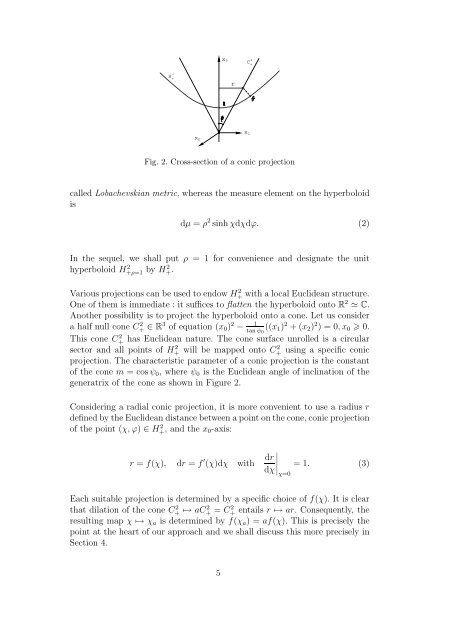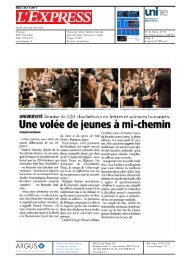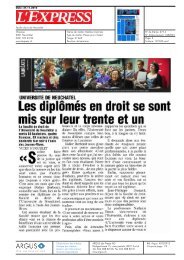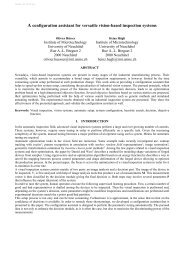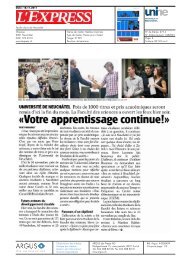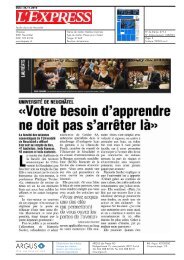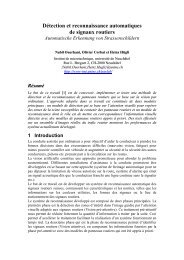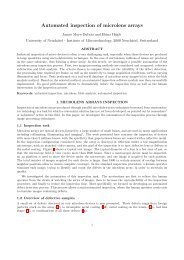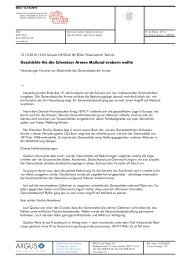Continuous Wavelet Transform on the Hyperboloid - Université de ...
Continuous Wavelet Transform on the Hyperboloid - Université de ...
Continuous Wavelet Transform on the Hyperboloid - Université de ...
Create successful ePaper yourself
Turn your PDF publications into a flip-book with our unique Google optimized e-Paper software.
0<br />
x<br />
0<br />
C 2 +<br />
H 2 +<br />
r<br />
0<br />
x<br />
2<br />
x<br />
1<br />
Fig. 2. Cross-secti<strong>on</strong> of a c<strong>on</strong>ic projecti<strong>on</strong><br />
called Lobachevskian metric, whereas <strong>the</strong> measure element <strong>on</strong> <strong>the</strong> hyperboloid<br />
is<br />
dµ = ρ 2 sinh χdχdϕ. (2)<br />
In <strong>the</strong> sequel, we shall put ρ = 1 for c<strong>on</strong>venience and <strong>de</strong>signate <strong>the</strong> unit<br />
hyperboloid H 2 +ρ=1 by H 2 +.<br />
Various projecti<strong>on</strong>s can be used to endow H+ 2 with a local Eucli<strong>de</strong>an structure.<br />
One of <strong>the</strong>m is immediate : it suffices to flatten <strong>the</strong> hyperboloid <strong>on</strong>to R 2 ≃ C.<br />
Ano<strong>the</strong>r possibility is to project <strong>the</strong> hyperboloid <strong>on</strong>to a c<strong>on</strong>e. Let us c<strong>on</strong>si<strong>de</strong>r<br />
a half null c<strong>on</strong>e C+ 2 ∈ R 3 of equati<strong>on</strong> (x 0 ) 2 − 1<br />
tan ψ 0<br />
((x 1 ) 2 +(x 2 ) 2 )=0,x 0 0.<br />
This c<strong>on</strong>e C+ 2 has Eucli<strong>de</strong>an nature. The c<strong>on</strong>e surface unrolled is a circular<br />
sector and all points of H+ 2 will be mapped <strong>on</strong>to C+ 2 using a specific c<strong>on</strong>ic<br />
projecti<strong>on</strong>. The characteristic parameter of a c<strong>on</strong>ic projecti<strong>on</strong> is <strong>the</strong> c<strong>on</strong>stant<br />
of <strong>the</strong> c<strong>on</strong>e m =cosψ 0 ,whereψ 0 is <strong>the</strong> Eucli<strong>de</strong>an angle of inclinati<strong>on</strong> of <strong>the</strong><br />
generatrix of <strong>the</strong> c<strong>on</strong>e as shown in Figure 2.<br />
C<strong>on</strong>si<strong>de</strong>ring a radial c<strong>on</strong>ic projecti<strong>on</strong>, it is more c<strong>on</strong>venient to use a radius r<br />
<strong>de</strong>fined by <strong>the</strong> Eucli<strong>de</strong>an distance between a point <strong>on</strong> <strong>the</strong> c<strong>on</strong>e, c<strong>on</strong>ic projecti<strong>on</strong><br />
of <strong>the</strong> point (χ, ϕ) ∈ H 2 + ,and<strong>the</strong>x 0-axis:<br />
r = f(χ), dr = f ′ (χ)dχ with<br />
dr<br />
=1. (3)<br />
dχ∣ χ=0<br />
Each suitable projecti<strong>on</strong> is <strong>de</strong>termined by a specific choice of f(χ). It is clear<br />
that dilati<strong>on</strong> of <strong>the</strong> c<strong>on</strong>e C 2 + ↦→ aC 2 + = C 2 + entails r ↦→ ar. C<strong>on</strong>sequently, <strong>the</strong><br />
resulting map χ ↦→ χ a is <strong>de</strong>termined by f(χ a )=af(χ). This is precisely <strong>the</strong><br />
point at <strong>the</strong> heart of our approach and we shall discuss this more precisely in<br />
Secti<strong>on</strong> 4.<br />
5


